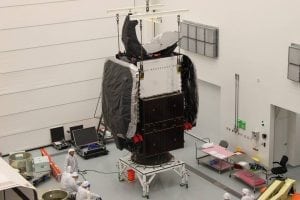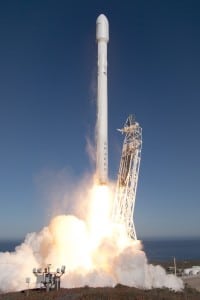Latest News
[Via Satellite 11-25-13] Today at precisely 5:37 p.m. EST the window opens for a historic event in the satellite launch industry. It is the time when SpaceX will attempt its first commercial satellite launch ever. Using an updated model of its Falcon 9 rocket dubbed v1.1, SpaceX will transport SES’s SES 8 satellite into geosynchronous orbit.
The eyes of the satellite industry are on Cape Canaveral, Fla. today as the success of this launch would mean a turning point for the launch sector not just from a technology point of view but also from a business perspective.
“We chose to be the first commercial user of SpaceX for a certain reason. We know as we go forward into these various different growth markets that it is absolutely critical that we have a cost-effective and efficient way to get to orbit, and that’s really what SpaceX has brought us,” said Martin Halliwell, CTO of SES during a media briefing yesterday at Cocoa Beach, Fla.
But one of the main concerns around the industry has been the performance of the v1.1 due to the failure to reignite the upper stage during the launch of the Canadian CASSIOPE satellite on Sept. 29. While this failure didn’t affect the mission, as a reignite was not necessary to orbit CASSIOPE, this step is critical for SES 8’s launch success, according to Elon Musk, CEO and CTO of SpaceX. However, he said this issue has been successfully resolved and that he is positive about today’s launch.
“We’re very appreciative that SES would place their faith on SpaceX. One thing I can say with certainty is that we’ve done everything we could possibly think of to maximize the probability of success for the mission,” Musk said.
And Halliwell agrees. He and his team are extremely confident that the launch will be a success mostly because of the open relationship SES and SpaceX have had for this mission. “We crawled all over it [the Falcon 9 v1.1 rocket], believe me, and we’re happy,” he said.
During this launch, however, SpaceX will not be attempting an ocean landing of the rocket’s first stage. Musk made the announcement during the media briefing saying that while SES gave them permission to reserve enough propellant on the first stage, “we didn’t want to take a chance,” he said understanding the importance of this mission’s success not just for SES and SpaceX but for the overall satellite launch sector.
“I don’t want to tempt fate, I’m always relatively suspicious about that but I think [the SES 8 launch] is going to have a pretty significant impact on the world launch market and the launch industry because our prices are the most competitive of any in the world, and in order for the other launch companies to compete, they therefore will have to improve their designs and really strive to have next-generation rocket technology,” Musk said. “I think SpaceX could be a powerful forcing function for the improvement of rocket technology; not just [for] the stuff we do ourselves but in that we will force other rocket companies to either develop new technology that’s a lot better or to exit the launch market.”
The SES 8 satellite will bring expanded capacity to the Southeast Asia region, as it is co-located with the NSS 6 satellite at 95 degrees east. It was built by Orbital Sciences in Dulles, Va. and is equipped with 24 transponders of 36 MHz capacity.
Stay connected and get ahead with the leading source of industry intel!
Subscribe Now
